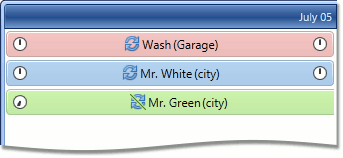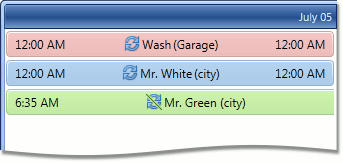SchedulerAppointmentDisplayOptions.TimeDisplayType Property
Specifies how the start and end time of the appointment should be displayed - using icons or digits.
Namespace: DevExpress.Xpf.Scheduler
Assembly: DevExpress.Xpf.Scheduler.v20.2.dll
NuGet Packages: DevExpress.WindowsDesktop.Wpf.Scheduler, DevExpress.Wpf.Scheduler
Declaration
Property Value
| Type | Description |
|---|---|
| AppointmentTimeDisplayType | A AppointmentTimeDisplayType enumeration value specifying how to display the appointment time. |
Available values:
| Name | Description |
|---|---|
| Auto | The start and end time is automatically shown either as text or as clock. |
| Clock | The start and end time is always shown as clock.
|
| Text | The start and end time is always shown as text.
|
Property Paths
You can access this nested property as listed below:
| Object Type | Path to TimeDisplayType |
|---|---|
| DayView |
|
| FullWeekView |
|
| MonthView |
|
| TimelineView |
|
| WeekView |
|
| WorkWeekView |
|
Remarks
Important
You are viewing documentation for the legacy WPF Scheduler control. If you’re starting a new project, we strongly recommend that you use a new control declared in the DevExpress.Xpf.Scheduling namespace. If you decide to upgrade an existing project in order to switch to the updated scheduler control, see the Migration Guidelines document.
Use the TimeDisplayType property to specify whether the start and end time of the appointment should be displayed as clock icons, or as digits.
| TimeDisplayType = Clock | TimeDisplayType = Text |
|---|---|
 |
 |
Related GitHub Examples
The following code snippet (auto-collected from DevExpress Examples) contains a reference to the TimeDisplayType property.
Note
The algorithm used to collect these code examples remains a work in progress. Accordingly, the links and snippets below may produce inaccurate results. If you encounter an issue with code examples below, please use the feedback form on this page to report the issue.

